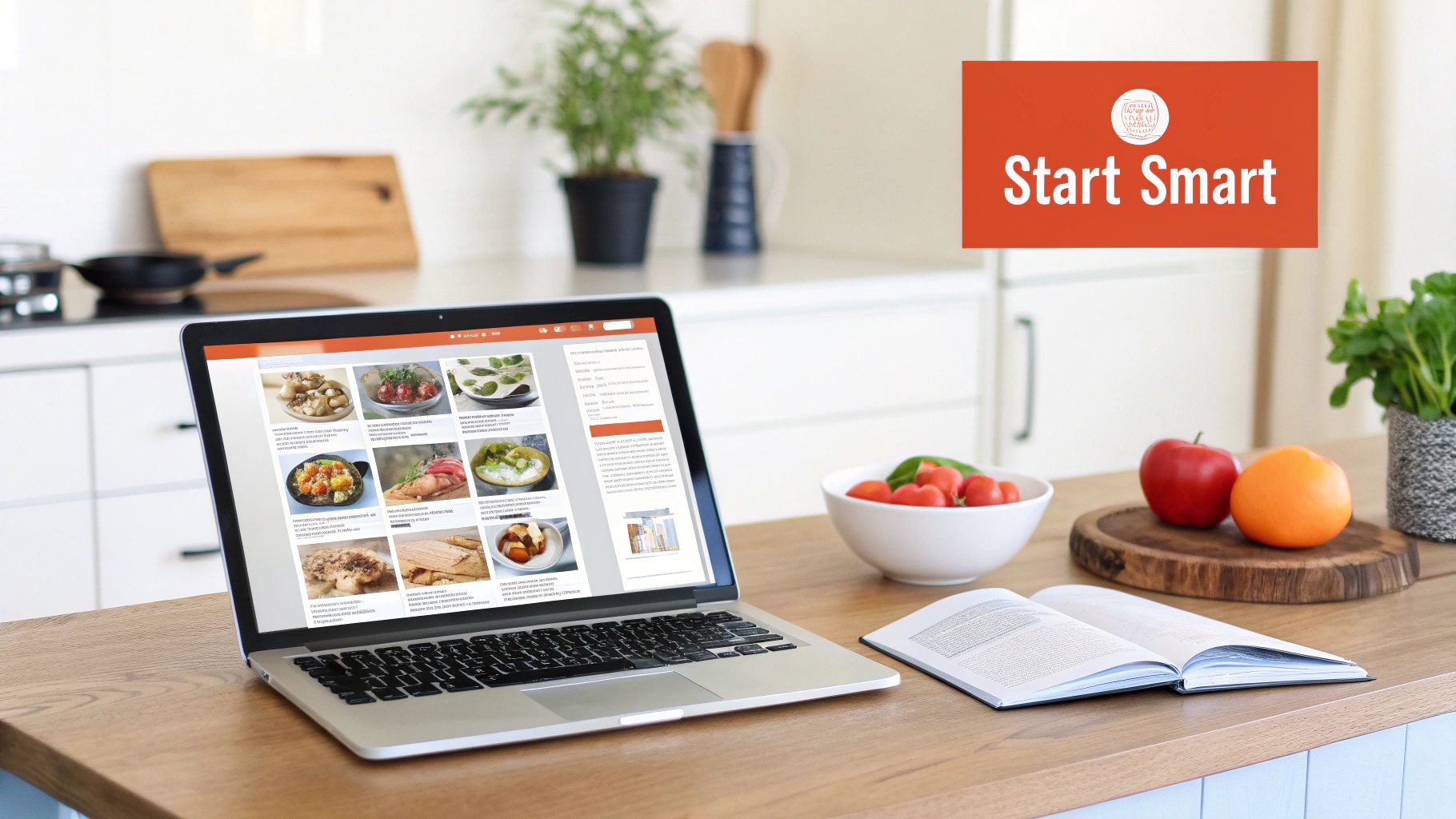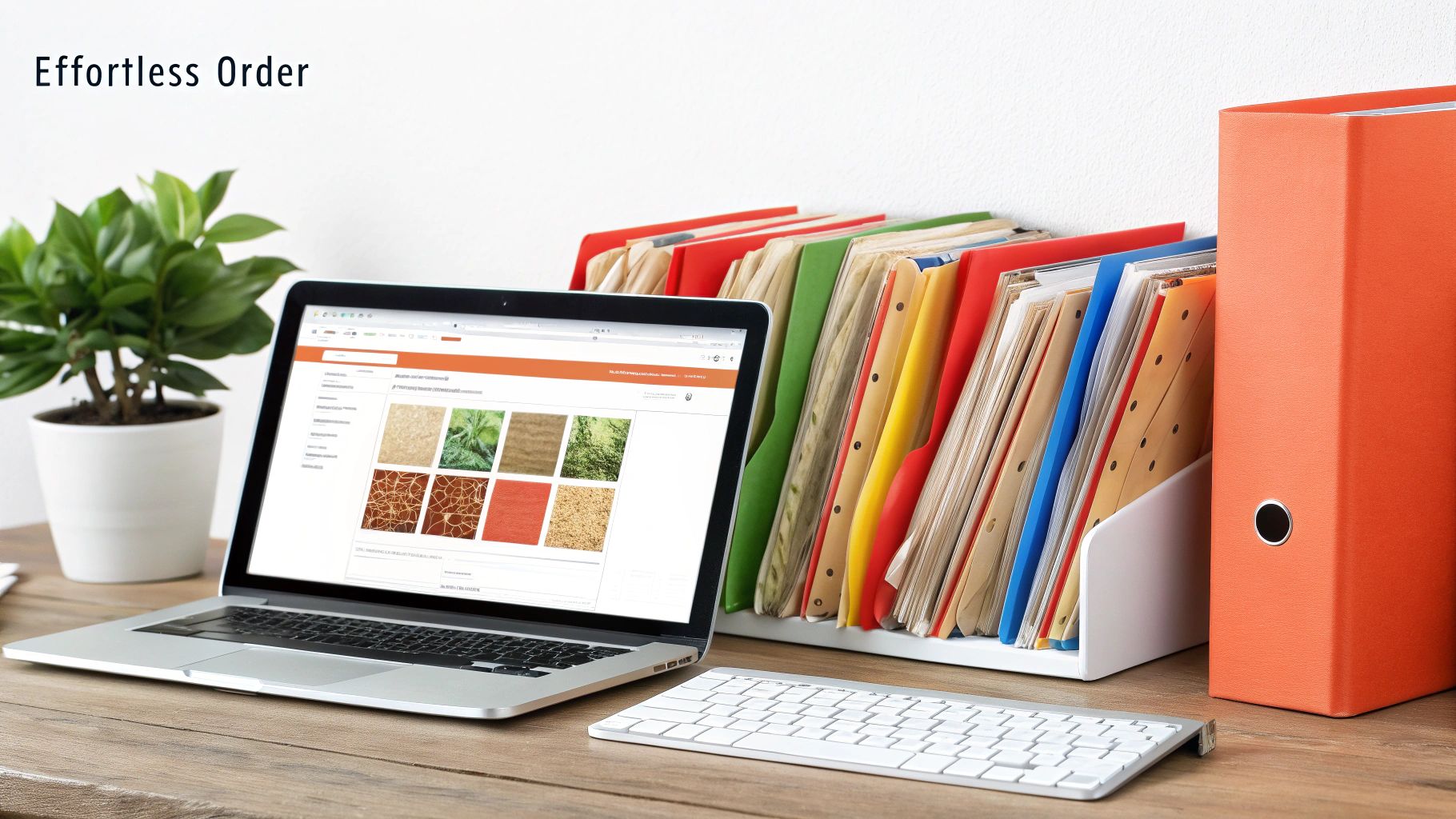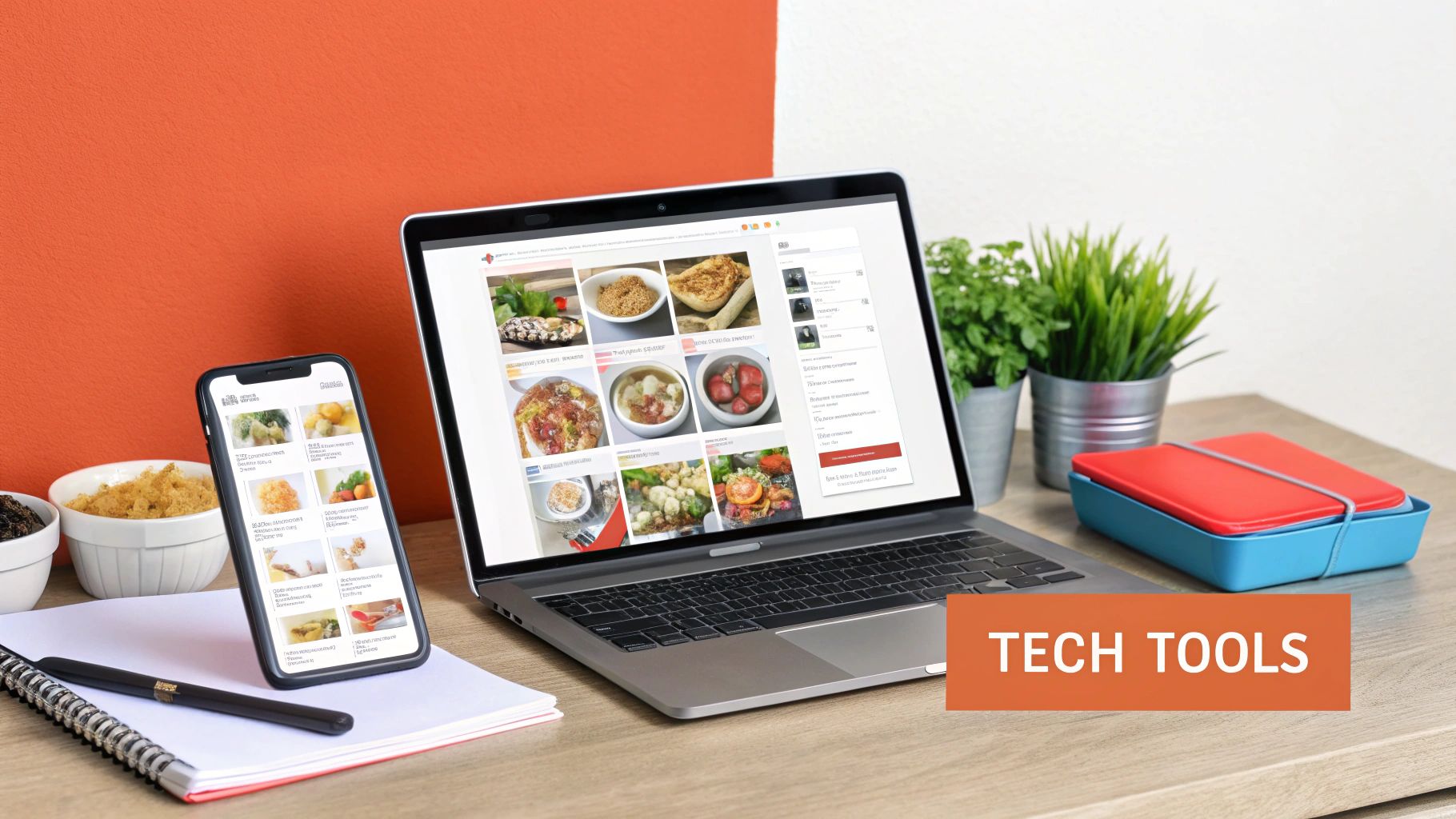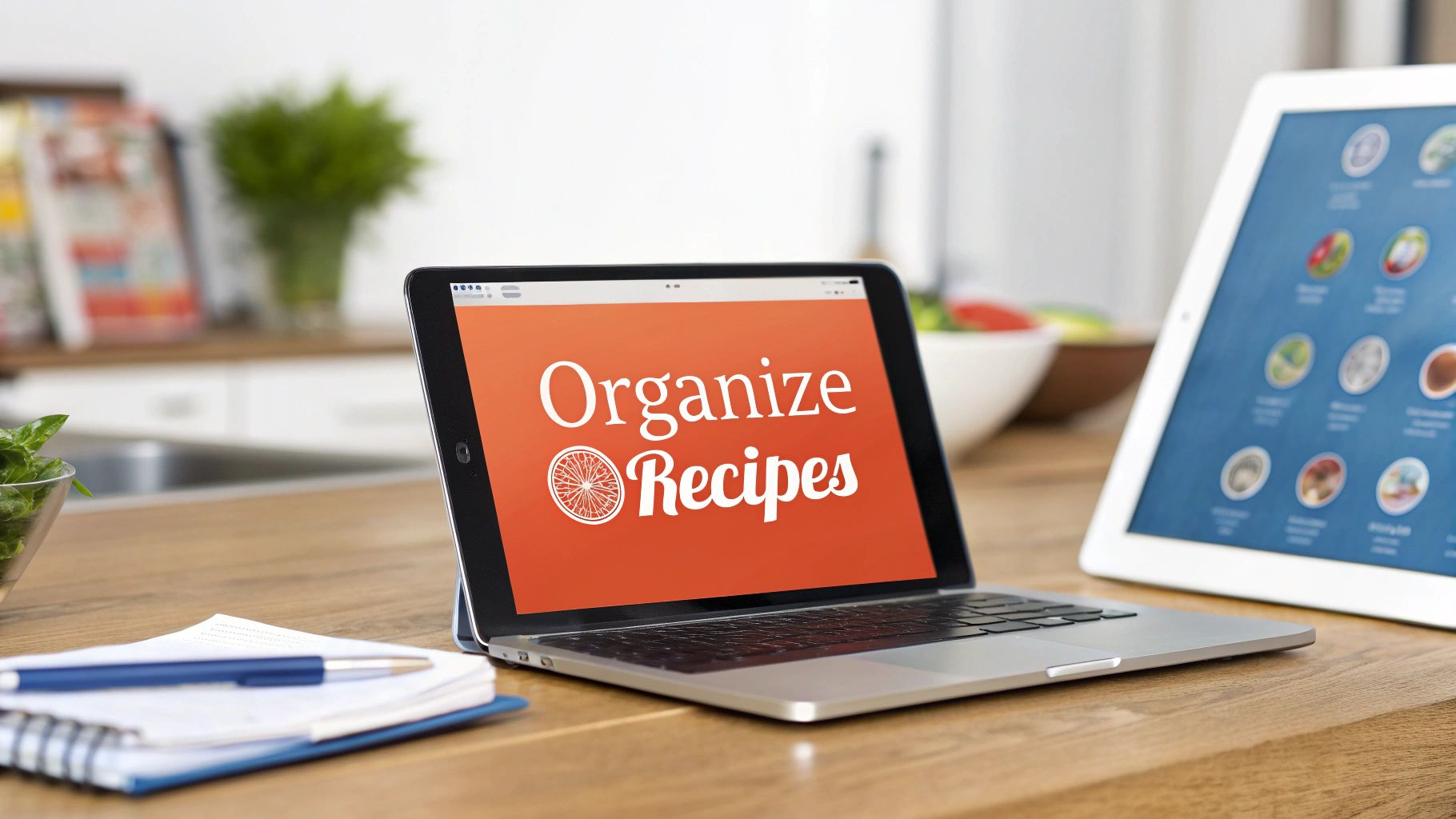Why Your Digital Recipe Collection Needs Organization Now
That overflowing bookmarks folder and the endless scroll through screenshots? Let's face it – that jumble of digital recipes isn't working anymore. The sheer volume of culinary inspiration available online presents both a treasure trove of possibilities and a significant organizational challenge for home cooks. Finding the perfect recipe for tonight's dinner can feel more like a digital scavenger hunt than a joyful experience.
This explosion of digital content has fundamentally changed how we interact with recipes. We're no longer confined to static cookbooks. Now, we have instant access to a global culinary landscape. For example, you can discover authentic Pad Thai recipes from Thai food bloggers, learn grandma's secret cookie recipe via a shared Google Doc, or master sourdough bread making with instructional YouTube videos. However, this abundance can quickly become overwhelming without a solid organizational strategy.
Additionally, the digital recipe consumption market is experiencing rapid growth, driven by the shift away from traditional cookbooks and towards digital platforms. As of 2024, this market was valued at USD 625.91 million and is projected to reach USD 1,706.30 million by 2031, growing at a CAGR of 15.40%. This growth is fueled by technological advancements, improved internet accessibility, and the increasing adoption of smartphones. Explore this topic further here. This influx of digital recipes makes effective organizational tools and techniques a necessity.
Benefits of an Organized Recipe Collection
Organizing your online recipes isn’t just about tidying up your digital space; it’s about transforming your entire cooking experience. A well-structured system offers several key benefits:
-
Saves Time: Quickly locate recipes without sifting through endless bookmarks or screenshots. Imagine having all your weeknight dinner options readily available in a dedicated collection.
-
Reduces Stress: Eliminate the frustration of losing treasured recipes. No more frantic searches just moments before dinner prep.
-
Inspires Creativity: Easily browse categorized recipes, sparking new ideas and encouraging culinary experimentation. This can lead to discovering new favorite dishes and expanding your cooking repertoire.
-
Simplifies Meal Planning: A structured collection streamlines meal planning by allowing you to filter recipes based on dietary restrictions, available ingredients, or desired cooking time.
-
Preserves Family Favorites: Securely store and easily share cherished family recipes across generations, building a digital legacy of culinary traditions.
For more general tips on content management, see InBlog's Blog. These broader organizational principles can also apply to managing your digital recipe collection.
Overcoming Common Recipe Management Challenges
Many home cooks struggle with common organizational hurdles. Recognizing these challenges is the first step towards implementing effective solutions:
-
Scattered Sources: Recipes saved across multiple platforms – bookmarks, screenshots, emails, and various recipe apps – make it difficult to find what you need.
-
Inconsistent Formatting: Recipes copied from different sources lack uniformity, making them difficult to browse and compare.
-
Lack of Categorization: A large, uncategorized collection becomes overwhelming and difficult to navigate.
-
Difficulty Sharing: Sharing recipes with friends and family becomes cumbersome without a central, organized system.
These challenges highlight the need for a dedicated system designed specifically for organizing online recipes. By addressing these issues head-on, you can unlock the true potential of your digital recipe collection.

Digital Tools That Transform Recipe Chaos Into Order

Tired of bookmarking recipes and taking screenshots? Recipe management apps offer a better way to organize your growing online recipe collection. These tools go beyond simple storage, actively improving how you interact with your recipes.
For example, some apps automatically extract ingredients directly from website links, creating shopping lists for you. This saves time and reduces errors from manual entry. Smart categorization also lets you organize recipes based on your cooking style, dietary needs, and even the equipment you have.
This personalized approach makes finding the right recipe much easier. The popularity of recipe apps reflects this convenience. The market, valued at USD 5.80 billion in 2024, is projected to reach USD 14.27 billion by 2033, a 10.52% CAGR. These apps offer ingredient-based searches, video tutorials, and meal planning. You can find more statistics here.
Key Features to Consider in Recipe Organization Apps
Choosing the right recipe organization tool can feel overwhelming. Look for these key features to effectively manage your digital collection:
-
Web Clipping and Import: Save recipes from any website quickly using browser extensions or by pasting URLs, avoiding manual entry.
-
Cross-Platform Synchronization: Access your recipes on any device—smartphones, tablets, or computers—so your collection is always available.
-
Tagging and Categorization: Create a personalized system for tagging recipes based on cuisine, ingredients, dietary restrictions, or anything else.
-
Smart Search: Use powerful search functionality that goes beyond keywords, searching within recipe titles, ingredients, and instructions.
-
Meal Planning Integration: Connect your recipes to meal planning tools for a seamless workflow from recipe inspiration to grocery list creation.
The following table summarizes some of the top options and their features:
To help you choose the best app for your needs, we've compiled a comparison of popular recipe organization apps. This table highlights the key features, cross-platform availability, pricing, and user ratings of each app.
Top Recipe Organization Apps Comparison
| App Name | Key Features | Cross-Platform? | Price | User Rating |
|---|---|---|---|---|
| Paprika | Web clipping, meal planning, pantry management | Yes | Paid | 4.8 |
| Plan to Eat | Meal planning, shopping list generation, recipe import | Yes | Subscription | 4.6 |
| Copy Me That | Web clipping, recipe organization, shopping list creation | Yes | Free/Paid | 4.7 |
| BigOven | Recipe search, meal planning, grocery list | Yes | Free/Paid | 4.5 |
| Whisk | Recipe discovery, meal planning, shopping list, dietary tracking | Yes | Free | 4.4 |
This table offers a quick overview of some popular choices. Remember to consider your specific needs and preferences when making your final decision. Which features are most important to you? What's your budget?
Choosing the Right Recipe App for You
The perfect recipe app depends on how you cook. Options include dedicated recipe apps, note-taking apps, and even spreadsheet software like Google Sheets. For more information, check out this helpful resource: How to organize recipes effectively.
Leveraging Recipe Apps for Professional Use
For food bloggers and chefs who manage thousands of recipes, robust organization is essential. Features like bulk import, advanced tagging, and collaboration tools become crucial for maintaining a searchable recipe database. This allows professionals to manage their content and share it effectively.
Building a Tagging System That Actually Makes Sense
Many home cooks start organizing online recipes with broad categories like "Dinner" or "Dessert." However, as your recipe collection grows, this simple approach quickly becomes overwhelming. A truly effective system requires a more nuanced approach: a well-defined tagging system. This mirrors how professional chefs and food bloggers organize their extensive recipe libraries, ensuring easy access and sparking culinary creativity.
Thinking Beyond Basic Categories
Building a practical tagging system means thinking multi-dimensionally. Cuisine type ("Italian," "Mexican") is a good starting point, but consider adding tags for other aspects of your recipes:
- Preparation Methods: "Slow Cooker," "One-Pot," "Grill"
- Dietary Considerations: "Vegetarian," "Gluten-Free," "Vegan"
- Occasion Suitability: "Weeknight Dinner," "Holiday," "Potluck"
- Seasonal Availability: "Spring," "Summer," "Fall," "Winter"
This multi-faceted approach allows you to quickly find exactly what you're looking for, such as a vegetarian slow cooker recipe perfect for a fall weeknight dinner.
Avoiding Common Tagging Mistakes
One common mistake is creating too many specific tags. This can lead to confusion and redundant tags. For example, instead of tagging recipes with both "Chicken" and "Poultry," use the broader "Poultry" tag. Then, use your search function to find chicken recipes within the "Poultry" category. Another pitfall is inconsistency. Decide on capitalization and pluralization rules from the beginning (e.g., "Slow Cooker" vs. "slowcooker," "Desserts" vs. "Dessert") to keep your database clean and easily searchable.
Structuring Your Tags
Organizing your tags effectively transforms a chaotic collection into an intuitive digital cookbook. You might be interested in: How to master recipe categorization. One effective method is creating a tagging hierarchy. Start with broad categories (e.g., "Main Courses") and then create subcategories (e.g., "Poultry," "Beef," "Seafood"). Within these subcategories, use specific tags like "Chicken," "Roast Beef," or "Salmon." This hierarchical structure lets you browse recipes broadly or filter by very specific criteria. To further improve your productivity in the kitchen, check out boost productivity with SaaS tools.
Maintaining and Evolving Your System
Your tagging system should be a living document, adapting as your culinary interests expand. Regularly review and refine your system, merging redundant tags, adding new ones, and maintaining consistency. This ongoing maintenance prevents your carefully organized collection from becoming disorganized. Implementing these strategies creates a robust and adaptable system that evolves alongside your cooking style.

Beyond Basic Folders: Advanced Recipe Categorization
Organizing your online recipes effectively goes beyond simple tagging. Think about how you actually cook and plan meals. This section explores strategic categorization systems that align with your cooking habits. We’ll examine how well-organized home cooks create frameworks for grouping recipes, moving beyond basic labels.
Categorization Frameworks That Work
Consider these practical criteria for organizing your recipes, much like creating virtual recipe binders tailored to your needs:
- Preparation Time: "30-Minute Meals," "Quick Bites," "Slow Cooker Recipes"
- Complexity Level: "Beginner-Friendly," "Intermediate," "Advanced Techniques"
- Budget Considerations: "Budget-Friendly Meals," "Special Occasion Dishes"
- Nutritional Profiles: "High-Protein," "Low-Carb," "Vegetarian," "Vegan"
These categories allow you to quickly locate recipes suitable for weeknight dinners, weekend projects, or special occasions. For example, if you're short on time, the "30-Minute Meals" category provides instant access to quick and easy recipes.
Specialized Collections for Different Needs
Creating specialized collections adds another layer of organization. Think of these as virtual binders within your digital recipe library:
- Weeknight Dinners: Focus on quick, easy recipes.
- Entertaining: Include impressive dishes for guests.
- Batch Cooking: Gather recipes ideal for making large quantities.
- Holiday Meals: Organize recipes by holiday (Thanksgiving, Christmas, etc.).
These collections streamline menu planning. Additionally, they make finding the right recipes for any occasion effortless. This organized system saves time and reduces stress.
Building a System for Efficient Meal Planning
Integrating your categorization system with your meal planning process dramatically improves efficiency. When planning your weekly menu, you can filter recipes based on various factors:
- Available Ingredients: Check your pantry and refrigerator, then search for recipes that use those ingredients.
- Time Constraints: Choose recipes from your "Quick Bites" or "30-Minute Meals" collections for busy weeknights.
- Dietary Needs: Quickly locate recipes that fit your specific dietary restrictions using tags like "Gluten-Free" or "Vegan."
- Budget: Plan your meals around budget-friendly recipes when necessary.
This structured approach takes the guesswork out of meal planning. It ensures you always have delicious and appropriate meal options at your fingertips. The global recipe website market is experiencing significant growth, projected to reach USD 10.5 billion by 2033, with a CAGR of 6.5% from 2025 to 2033. This growth is fueled by the increasing popularity of online cooking and the ease of accessing recipes via digital devices. Find more detailed statistics here.
Regularly Review and Refine
Just like any organizational system, your recipe categorization needs regular maintenance. Periodically review your collections and tags. This ensures your system stays relevant to your evolving cooking style and preferences.

Accessing Your Recipes Anywhere: Multi-Device Strategies
Having a well-organized digital recipe collection is great, but it loses its value if you can't access it when you need it. Whether you're in the kitchen, at the grocery store, or at a friend's house, your recipes should always be at your fingertips. This section explores how to make your recipes readily available across all your devices, ensuring technology doesn't hinder your culinary creativity. We'll cover cloud-based solutions, backups, and offline availability. Think of it as your personalized cookbook, accessible anywhere.
Cloud-Based Solutions for Seamless Syncing
Cloud-based recipe apps are a powerful way to sync your organized recipes across multiple devices. These apps act as a central hub, storing your categorized recipes and making them accessible on your smartphone, tablet, or computer. This eliminates manual transfers or emailing recipes, ensuring consistency across all platforms. Any updates made on one device will automatically appear on all others.
Backing Up Your Precious Recipes
Losing your entire recipe collection due to a computer crash or lost phone would be devastating. Regular backups are essential for protecting your digital culinary treasures. While cloud-based apps often have automatic backup features, consider creating additional backups. External hard drives or cloud storage services like Google Drive or Dropbox provide an extra layer of security.
Offline Access for Uninterrupted Cooking
Not every kitchen has perfect Wi-Fi. Many dedicated recipe apps offer offline access, which is perfect for unreliable internet connections. Download your categorized collections or individual recipes before cooking to ensure access even without internet. Some apps also offer print options, creating physical backups of essential recipes.
Device-Specific Guidance
Different device ecosystems (Apple, Android, Windows) have their own strengths and weaknesses regarding recipe management. Some apps specialize in specific platforms, while others offer cross-platform compatibility. Understanding these nuances helps you choose the right tools for your devices.
-
Apple Ecosystem: Leverage iCloud integration for seamless syncing across iPhones, iPads, and Macs. The built-in Reminders app, as discussed here, can be surprisingly effective for organizing recipes.
-
Android Devices: Google Keep offers cloud-based storage and cross-device syncing, similar to Apple's Reminders. The Google Play Store also offers many third-party apps specifically for recipe management and organization.
-
Windows Computers: While some dedicated recipe apps have desktop versions, cloud-based solutions ensure consistency across all your devices, including your Windows computer.
To help you choose the right method for organizing your recipes, take a look at this comparison table:
To help you understand which method works best for you, we have compiled this table showcasing the effectiveness of different recipe organization methods:
Recipe Organization Methods Effectiveness
| Organization Method | Avg. Recipe Retrieval Time | User Satisfaction | Learning Curve | Scalability |
|---|---|---|---|---|
| Handwritten Recipe Book | High (5+ minutes) | Moderate | Low | Low |
| Spreadsheet | Medium (2-4 minutes) | Moderate | Medium | Medium |
| Dedicated Recipe App | Low ( <1 Minute) | High | Medium | High |
| Cloud-Based Note-Taking App | Medium (1-3 minutes) | Moderate | Low | High |
As you can see, dedicated recipe apps and cloud-based note-taking apps excel in scalability and offer quicker retrieval times. However, handwritten books and spreadsheets offer a lower learning curve but aren't as easily scaled or searched.
Troubleshooting Common Syncing Challenges
Syncing issues can occasionally arise. Common problems include outdated app versions, incorrect login credentials, or conflicts between multiple devices. Most recipe apps have troubleshooting guides or customer support to help resolve these issues. Regularly updating your apps can also prevent many syncing challenges.
From Organized Collection to Effortless Meal Planning
An organized online recipe collection becomes truly valuable when it seamlessly connects with your meal planning. Think of your categorized recipes as the building blocks for delicious, stress-free weekly menus. This section explores how to integrate your organized collection into a practical meal planning workflow. We’ll cover everything from filtering recipes to adapting plans for life's inevitable curveballs. It's about making your recipes work for you.
Connecting Your Recipes to Your Weekly Menu
Once you’ve organized your online recipes, you can leverage that organization for effortless meal planning. Meal planning experts recommend a weekly menu to save time, reduce food waste, and ensure balanced meals. However, without a well-organized system, meal planning can become overwhelming.
Filtering your recipe collection is key. For example, if you're focusing on budget-friendly meals, filter your recipes by a "Budget-Friendly" tag. This narrows your options and simplifies decisions. Similarly, if you're short on time, filtering by "30-Minute Meals" quickly presents quick and easy options. This filtering becomes incredibly powerful when combined with other criteria, like dietary restrictions or seasonal ingredients.
Building Flexible Meal Plans
Life rarely goes as planned. Building flexibility into your meal plans accommodates unexpected schedule changes or substitutions. One strategy is having a few "backup" recipes. These can be simple, adaptable recipes using pantry staples, allowing you to quickly pivot if your original plan changes.
Another approach is planning for leftovers. Cook extra portions of certain meals, making lunch or another dinner easier later in the week. This not only saves time but also helps reduce food waste.
Strategies to Minimize Food Waste
Meal planning is an excellent tool for minimizing food waste. By planning ahead, you can create a shopping list based on what you actually need. This targeted approach reduces impulse purchases and ensures you use perishable ingredients before they spoil.
Additionally, incorporating leftover ingredients into new recipes further reduces waste. Get creative! Turn leftover roasted chicken into chicken salad or soup.
Meal Planning Templates and Rotations
Creating template meal rotations simplifies planning, especially for busy individuals. A meal rotation might include a theme for each night (e.g., Meatless Mondays, Taco Tuesdays). This provides structure and reduces decision fatigue.
Within each theme, rotate through recipes from your organized collection. This prevents menu boredom and ensures variety while simplifying planning. You can even adapt these rotations seasonally.
Consider a system to track your meal rotations. This helps avoid repeating meals too frequently and allows adjustments based on your family's preferences.
Adapting to Changing Dietary Needs
Managing dietary needs requires a flexible approach. A well-organized recipe collection with appropriate tags (e.g., "Vegetarian," "Gluten-Free," "Dairy-Free") allows quick filtering.
For example, if a family member is vegetarian, you can easily plan meatless meals while ensuring others still enjoy their favorites.
By integrating these strategies, your recipe collection becomes a powerful tool for efficient, enjoyable meal planning. This system makes preparing delicious, stress-free meals a reality. It allows you to spend less time searching for recipes and more time enjoying cooking. For more advice on storing recipes online, check out The Best Way to Store Recipes Online.
Maintaining Organization Without the Endless Effort
A well-organized online recipe collection is a source of joy for any home cook. But just like a garden, it needs regular tending to prevent it from becoming overgrown and chaotic. This section offers practical strategies for maintaining your digital recipe garden without turning it into a second job. We'll explore efficient routines, digital decluttering, and using automation to ensure your collection remains a source of inspiration, not frustration.
Establishing Sustainable Maintenance Routines
Keeping your recipe collection organized shouldn't feel like a monumental task. Just as you wouldn't wait months to clean your kitchen, regular maintenance is key. Short, frequent updates are far more effective than infrequent overhauls. Try setting aside 15 minutes each week to review newly saved recipes. Tag them appropriately and place them in the correct categories. This prevents a backlog and keeps your system up-to-date. A monthly review is also helpful for deleting duplicates, updating outdated recipes, or refining your categories.
Digital Decluttering: Pruning Your Recipe Collection
Over time, digital recipe collections, like any collection, can accumulate clutter. Periodically review your saved recipes and ask yourself a few key questions:
- Have I actually made this recipe?
- Did I enjoy it enough to make it again?
- Do I have multiple versions of the same recipe?
- Are any recipes outdated or no longer relevant to my cooking style?
If the answer to most of these is no, consider deleting the recipe. For seldom-used but potentially valuable recipes, like family heirlooms, create a separate archive folder. This prevents clutter while preserving sentimental favorites. For more helpful tips, check out this guide: The Best Way to Store Recipes Online. It offers valuable insights into preserving and organizing your recipes effectively.
Refreshing Your Categorization as Your Cooking Evolves
Our tastes and cooking styles change over time, and our organizational systems should adapt along with them. If you've discovered a new cuisine you love, create a new category for it. If you're simplifying your cooking, update your categories to reflect that, such as creating a category for "Quick Weeknight Meals." This ensures your system stays relevant and useful, much like reorganizing your pantry to reflect your current eating habits.
Balancing Maintenance Time with Actual Cooking
The ultimate goal of organizing your recipes is to make cooking more enjoyable, not to create another chore. Find a balance between maintaining your collection and actually using it. Set realistic goals for organization, focusing on small, consistent efforts rather than large, infrequent overhauls. Think of it as prepping ingredients: a little upfront work saves significant time and stress during cooking.
Leveraging Automation Tools to Streamline Organization
Many tools can automate parts of the organizational process. Recipe management apps often automatically import ingredients and nutritional information, reducing manual entry. Some even suggest tags based on recipe content. Remember, however, to maintain the personal touch that makes your collection unique. Use automation as a support, not a replacement for your own organizational style.
By implementing these practical strategies, you can maintain a vibrant and accessible online recipe collection that truly serves your culinary needs. A well-maintained collection becomes a source of inspiration and enjoyment, making cooking less of a chore and more of a pleasure. Ready to transform your recipe chaos into culinary order? Recify, the innovative recipe management app, helps you save, organize, and access your recipes from any device. Turn your phone or tablet into a personalized digital cookbook. Visit Recify today and start cooking smarter, not harder!
